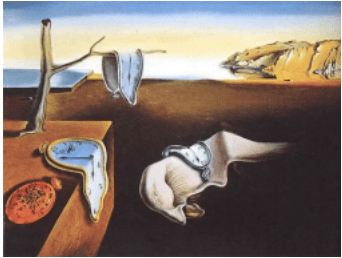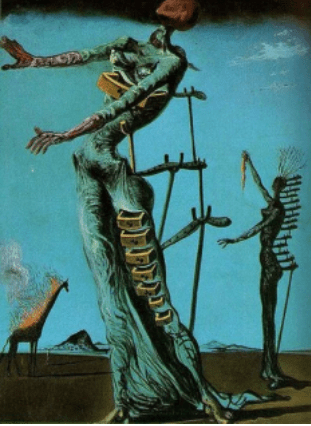Salvador Dali
by Katherine Johnson
The spanish painter, Salvador Dali, remains one of the most controversial and paradoxical artists of the twentieth century. His work occupies many minds as one of the great influencers of modern art and whose life work has become increasingly synonymous with surrealism itself. Dali, who was born in 1904, focused on cubism, futurism, and even type of metaphysical1 work which questioned predisposed ideas of artwork and what is considered to be beautiful art. He believed art should be thought provoking and did just that through the themes he depicted. These new ideas for his upsetting paintings and other works paved the way for the Surrealist movement in the 1930s. The Surrealist movement can be described as, “a cultural movement which developed in Europe in the aftermath of World War I and was largely influenced by Dada. The movement is best known for its visual artworks and writings and the juxtaposition of distant realities to activate the unconscious mind through the imagery.”2 Within this movement, artists are known for depicting unnerving and illogical scenes that mess with the mind by creating an image that many would say is unpleasant to look upon.
His major contribution to this category of art is the “Paranoiac-Critical method” which is a form of mental exercise that accesses the subconscious of your mind to create aesthetic inspirations for particular works. This method was used in his paintings to depict the imaginations of his dreams, which changed the real world to the world as Dali saw it. He was influenced mainly by the Renaissance period, but his twisted version of this traditional style is what truly made him famous. One of his most famous pieces, “La persistencia de la memoria” or the Persistence of Memory, was created in 1931 was iconic and one of the first to the many great pieces from Salvador Dali. The symbolism and contrasting of the melting watches on rocks and tree branches creates the hard versus soft aspect of the piece which ignited its acclaim. The Persistence of Memory has been much analyzed over the years as Dali never explained his work. The melting watches have been thought to be an unconscious symbol of the relativity of space and time; as a “symbol of mortality with the ants surrounding the watches representing decay; and as irrationality of dreams.”3

In addition to this piece and many other masterpieces, there is my personal favorite, “Jirafa en llamas” or the Burning Giraffe. Created in 1937, the Burning Giraffe is seen as an expression of his personal struggle with the civil war occuring in his home country during this time period. The painting depicts two feminine figures with undefined phallic shapes protruding from their backs. The hands, forearms and face of the nearest figure are stripped down to the muscular tissue beneath the skin. Prominently, there are opened drawers protruding from the left leg and chest of the figurine. Salvador Dali was a great admirer of famous neurologist Sigmund Freud and several paintings of Dali were influenced by Freudian theories. “These open drawers can be traced to Freud’s psychoanalytic method and refer to the inner, subconscious within man.”4 The burning giraffe image in the background was described by Dali as, “the masculine cosmic apocalyptic monster.” He believed it to be a premonition of war. However, personally this is not what comes to my mind. In my opinion the painting evokes a feeling of disturbance, of course, but not only that. The artwork creates an image of instability and, personally, this can be translated to many things throughout a person’s life. The precarious position of the womanly figure, being held up by large sticks or bars, gives light to the struggles that constantly can weigh someone down.

Overall, his work with symbolism, the proactive moves he made against traditional artists, and the beauty of these renaissance period pieces only allow me to criticise my ideas of what art truly means to me. Throughout my life, I have believed that artwork should be “timelessly beautiful”, as I would put it, and I have used this straightforward thinking throughout the creation of all of the pieces that I have created. I am so proud of my work, however, my new reflection is this: Art does not have to be beautiful, infact, to arouse some emotions within the human brain, some art must be “ugly”, Art is imagination, it is freeing, and it questions conventional thinking. This is exactly what Salvador Dali did.
“The only difference between me and a madman is that I’m not mad.”
-Salvador Dali
1 Salvador Dali: 150 Famous Paintings Analysis, Complete Works & Bio (dalipaintings.com)2Surrealism | The Art Institute of Chicago (artic.edu)
3 10 Most Famous Paintings by Salvador Dali | Learnodo Newtonic (learnodo-newtonic.com)4 The Burning Giraffe by Salvador Dali (salvadordaliprints.org)